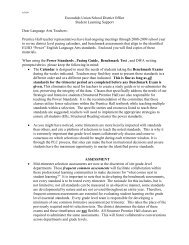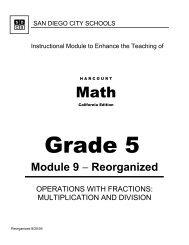Module 5 â Reorganized - eusddata
Module 5 â Reorganized - eusddata
Module 5 â Reorganized - eusddata
You also want an ePaper? Increase the reach of your titles
YUMPU automatically turns print PDFs into web optimized ePapers that Google loves.
Harcourt Math−Grade 5 MODULE 5<br />
MATERIALS:<br />
LESSON<br />
FOCUS:<br />
CALIFORNIA<br />
STANDARDS:<br />
Purpose of<br />
Lesson:<br />
LAUNCH:<br />
Introduce<br />
students to<br />
concepts.<br />
EXPLORE:<br />
Work with the<br />
concept. Focus<br />
on students<br />
“doing<br />
mathematics.”<br />
PRACTICE:<br />
Focus on<br />
Communication<br />
and<br />
Representation.<br />
SUMMARIZE:<br />
Connect purpose<br />
to activities.<br />
DAY 1<br />
UNIT 3: Multiply Whole Numbers and Decimals<br />
LESSON 9.1<br />
Practice 9.2 one per student<br />
Multiply by 1-Digit Numbers<br />
Number Sense: 1.0<br />
Students compute with very large and very small numbers, positive integers,<br />
decimals, and fractions and understand the relationship between decimals,<br />
fractions, and percents. They understand the relative magnitudes of numbers.<br />
Mathematical Reasoning: 2.1<br />
Use estimation to verify the reasonableness of calculated results.<br />
Mathematical Reasoning 2.2<br />
Apply strategies and results from simpler problems to more complex problems.<br />
• Use estimation to determine reasonableness of a product & the number of<br />
digits in the product.<br />
• Multiply by a one-digit number using distributive property as one strategy.<br />
Problem of the Day, T.E. p. 146A. Discuss solutions.<br />
Learn, p. 146: Heavyweights. Write problem on board/overhead.<br />
• Ask students to:<br />
− Determine an estimate for the solution.<br />
− Share their strategy with a partner.<br />
− Calculate an exact answer.<br />
− Compare their estimate with their exact answer.<br />
− Share their solution strategies with the class.<br />
• Record the different strategies.<br />
Teach, p. 146, Modifying Instruction, discuss the reasoning behind this<br />
strategy.<br />
• Relate to Example of distributive property (a partial product strategy),<br />
p. 146 bottom, as a way to get the actual product.<br />
• Allow students to discuss and explain the process.<br />
Check, p. 147 #1. Discuss. Then, #5 & 6.<br />
• Student partners ESTIMATE FIRST, then try strategies use to solve.<br />
• Share strategies.<br />
Practice & Problem Solving, p. 147 #18-21 with a partner.<br />
• Show distributive property solutions for # 18 & 19.<br />
Practice 9.2 OR Practice & Problem Solving, p. 147 #15 – 17.<br />
• Estimate first.<br />
• Discuss strategies for solving.<br />
T.E. ASSESS, p. 147: DISCUSS<br />
T.E. ASSESS, p. 147: WRITE: In practice problem #2, how could you use<br />
addition to check your multiplication?<br />
• How did you use the distributive property when solving multiplication<br />
problems?<br />
HOMEWORK: Mixed Review, p. 147<br />
Advanced Learners T.E. p. 142F (See Challenge 9.4 TE 151 for more<br />
problems like this)<br />
<strong>Reorganized</strong> 9/04/04 8






